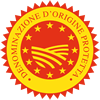Description
Asiago PDO is a semi-cooked cheese made with cow’s milk, produced in two typologies. Asiago PDO Fresco (Fresh), made with whole milk, has a sweet and delicate flavour, while Asiago PDO Stagionato (Mature), made with semi-skimmed milk, has a stronger flavour.
Production Area
The production area of Asiago PDO is within the territory of the Province of Vicenza; in two bordering areas in the provinces of Padua and Treviso, in the Veneto region: within the Province of Trento, in the Trentino-Alto Adige region.
Production Method
Calf rennet or a vegetarian coagulant is added to the milk – whole raw or pasteurised for the Fresco variety and raw semi-skimmed or thermised for the Stagionato variety – and potentially also probiotics/ milk starter culture and modest quantities of sodium chloride. After curdling and breaking of the curd, the product is semi-cooked. The Asiago PDO Fresco wheels are then pressed for a maximum of 12 hours. This is followed by dry salting or salting in brine. The minimum ripening period is 20 days from the production date for Asiago PDO Fresco, and 90 days for Asiago PDO Stagionato. Processing and aging must take place within the production area, in storerooms with a temperature not below 5 °C. Asiago PDO accompanied by the term “Prodotto della Montagna”, Mountain Product, (altitude higher than 600 m.a.s.l.), must be obtained from milk coming from mountain farms; in this case, the ripening process lasts a minimum of 30 days for the fresh cheese and 90 days for the mature cheese.
Appearance and Flavour
Asiago PDO Fresco has a thin and springy rind. The cheese is white or slightly straw-coloured, with irregular and defined eyes. Asiago PDO Stagionato has a smooth and even rind. The cheese is firm and ranges from straw-yellow to amber in colour, with a scattering of small to medium-sized eyes.
History
In around AD 1000, a tasty sheep’s milk cheese was produced on the plateau that gives the product its name, also known as the Altopiano dei Sette Comuni. In around the 16th century, sheep were replaced by cows. The processing of cow’s milk gave rise to the cheese-making technique that is still used by mountain farms today. The oldest type of Asiago cheese is the mature variety, whereas production of the fresh variety only began during the 1920s.
Gastronomy
Asiago PDO Fresco must be eaten within 10 days of purchase, whereas Asiago PDO Stagionato can be kept for up to one month. Sliced Asiago PDO should be wrapped in cling film and kept at a temperature of 8-9 °C. Asiago PDO Fresco can be eaten diced, with an aperitif or in salads, sandwiches, baked pasta and as a gourmet pizza topping. Asiago PDO Stagionato is best served with dried fruit at the end of a meal, or added to dishes to which you want to give more character and a decisive taste.
Marketing
The product is sold in the following typologies: Asiago PDO Fresco, which when ripened for more than 40 days may bear the indication Asiago PDO Fresco Riserva; Asiago PDO Stagionato (or Asiago PDO d'Alevo). The labels of the latter may also bear the words: "Mezzano" or "Stagionato Mezzano" (aged for four to ten months), "Vecchio" or Stagionato Vecchio"; aged for 10 to 15 months), "Stravecchio" or "Stagionato Stravecchio” (aged for over 15 months). Both typologies may indicate “Prodotto della Montagna” if produced in a mountain area. It is sold in whole wheels, pieces, wedges and pre-packed.
Distinctive Features
Asiago PDO is the only Protected Designation of Origin with two types of products which are produced with different processes: Asiago PDO Fresco and Asiago PDO Stagionato.





































